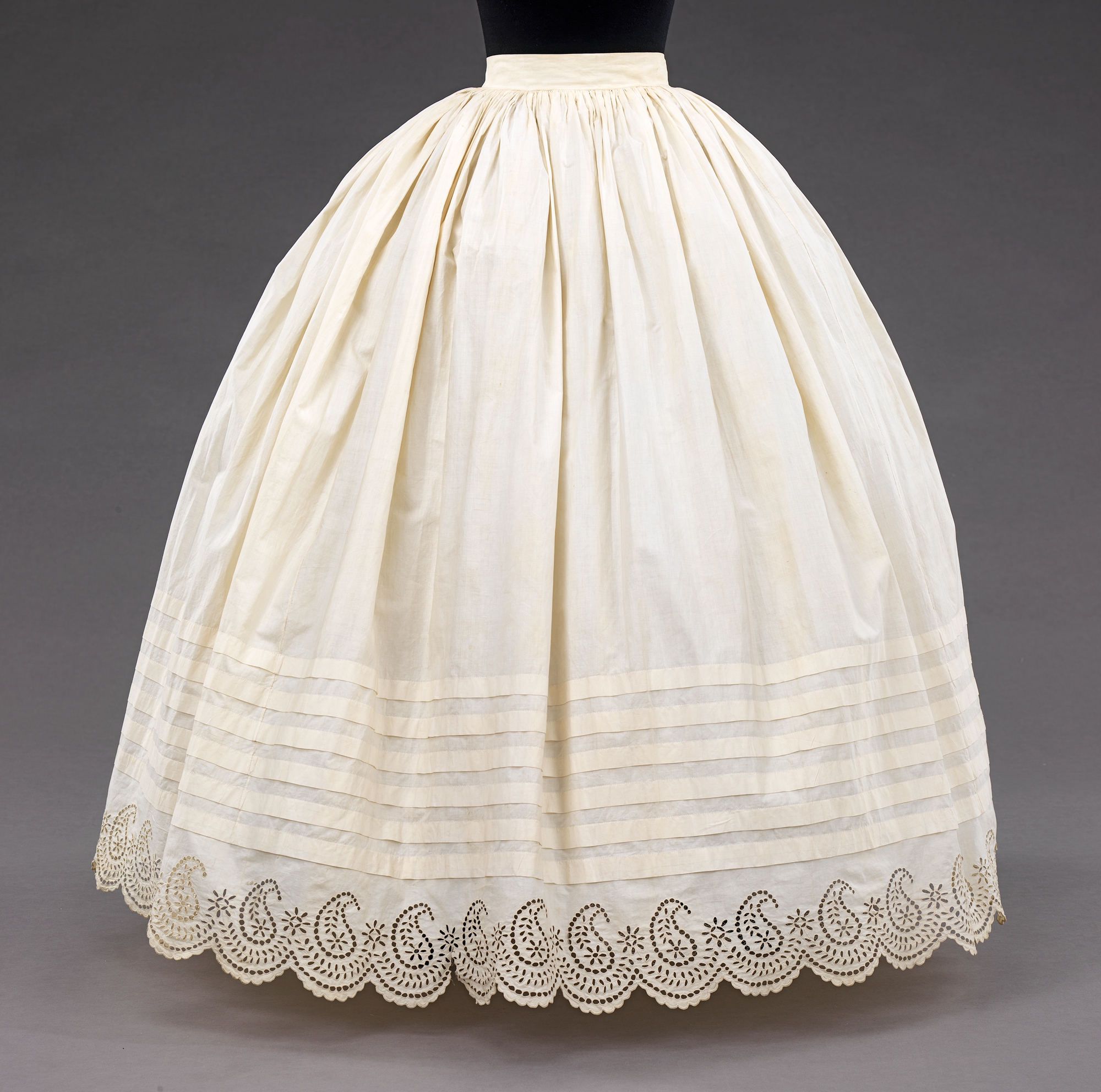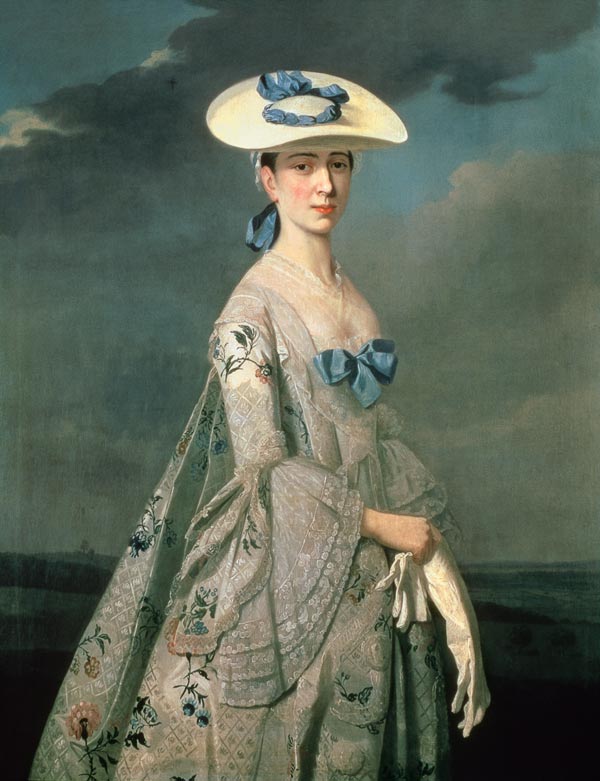|
Close-bodied Gown
A close-bodied gown, English nightgown, or ''robe à l'anglaise'' was a women's fashion of the 18th century. Like the earlier mantua, from which it evolved, the back of the gown featured pleats from the shoulder, stitched down to mould the gown closely to the body until the fullness was released into the skirt. Through the 1770s, the back pleats became narrower and closer to the center back, and by the 1780s these pleats had mostly disappeared and the skirt and bodice were cut separately.Feshman et al (1983), p. 235Takeda and Spilker (2010), p. 212 The gown was open in front, to reveal a matching or contrasting petticoat, and featured elbow-length sleeves, which were finished with separate frills called engageantes. Gallery File:Woman's Robe a l'Anglaise Ensemble LACMA M.59.25a-d (6 of 6).jpg, ''Robe à l'anglaise'', cotton embroidered in wool, shown with an embroidered kerchief, England, 1780s. LACMA, M.59.25a-c File:Woman's Robe a l'Anglaise Ensemble LACMA M.59.25a-d (1 of 6). ... [...More Info...] [...Related Items...] OR: [Wikipedia] [Google] [Baidu] |
Mantua (clothing)
A mantua (from the French or "mantle") is an article of women's clothing worn in the late 17th century and 18th century. Originally a loose gown, the later mantua was an overgown or robe typically worn over stays, stomacher and a co-ordinating petticoat. The mantua or was a new fashion that arose in the 1670s. Instead of a bodice and skirt cut separately, the mantua hung from the shoulders to the floor (in the manner of dresses of earlier periods) started off as the female version of the men's banyan, worn for 'undress' wear. Gradually it developed into a draped and pleated dress and eventually evolved into a dress worn looped and draped up over a contrasting petticoat and a stomacher. The mantua-and-stomacher resulted in a high, square neckline in contrast to the broad, off-the-shoulder neckline previously in fashion. The new look was both more modest and covered-up than previous fashions and decidedly fussy, with bows, frills, ribbons, and other trim, but the short string of ... [...More Info...] [...Related Items...] OR: [Wikipedia] [Google] [Baidu] |
Pleat
A pleat (plait in older English) is a type of fold formed by doubling fabric back upon itself and securing it in place. It is commonly used in clothing and upholstery to gather a wide piece of fabric to a narrower circumference. Pleats are categorized as ''pressed'', that is, ironed or otherwise heat-set into a sharp crease, or ''unpressed'', falling in soft rounded folds. Pleats sewn into place are called tucks. Types Accordion Accordion pleats or knife pleats are a form of tight pleating which allows the garment to expand its shape when moving. Accordion pleating is also used for some dress sleeves, such as pleating the end of the elbow, with the fullness of the pleat gathered closely at the cuff. This form of pleating inspired the "skirt dancing" of Loie Fuller. Accordion pleats may also be used in hand fans. Box Box pleats are knife pleats back-to-back, and have a tendency to spring out from the waistline.Picken, Mary Brooks, ''The Fashion Dictionary'', p. 257 They ha ... [...More Info...] [...Related Items...] OR: [Wikipedia] [Google] [Baidu] |
Petticoat
A petticoat or underskirt is an article of clothing, a type of undergarment worn under a skirt or a dress. Its precise meaning varies over centuries and between countries. According to the ''Oxford English Dictionary'', in current British English, a petticoat is "a light loose undergarment ... hanging from the shoulders or waist". In modern American usage, "petticoat" refers only to a garment hanging from the waist. They are most often made of cotton, silk or tulle. Without petticoats, skirts of the 1850s would not have the volume they were known for. In historical contexts (16th to mid-19th centuries), ''petticoat'' refers to any separate skirt worn with a gown, bedgown, bodice or jacket; these petticoats are not, strictly speaking, underwear, as they were made to be seen. In both historical and modern contexts, ''petticoat'' refers to skirt-like undergarments worn for warmth or to give the skirt or dress the desired attractive shape. Terminology Sometimes a petticoat may be ... [...More Info...] [...Related Items...] OR: [Wikipedia] [Google] [Baidu] |
Engageante
Engageantes are false sleeves worn with women's clothing. They were worn during the 18th and 19th centuries, with a brief revival in the 20th century. In the 18th century, engageantes took the form of ruffles or flounces of linen, cotton, or lace, tacked to the elbow-length sleeves then fashionable. In the mid-19th century, the term ''engageante'' was used for separate false sleeves, usually with fullness gathered tight at the wrist, worn under the open bell-shaped "pagoda" sleeves of day dress A dress (also known as a frock or a gown) is a garment traditionally worn by women or girls consisting of a skirt with an attached bodice (or a matching bodice giving the effect of a one-piece garment). It consists of a top piece that co ...es. The fashion reappeared briefly just after the turn of the 20th century. External links {{Commons category, EngageantesGlossary of 18th century dress terms [...More Info...] [...Related Items...] OR: [Wikipedia] [Google] [Baidu] |
Metropolitan Museum Of Art
The Metropolitan Museum of Art of New York City, colloquially "the Met", is the largest art museum in the Americas. Its permanent collection contains over two million works, divided among 17 curatorial departments. The main building at 1000 Fifth Avenue, along the Museum Mile on the eastern edge of Central Park on Manhattan's Upper East Side, is by area one of the world's largest art museums. The first portion of the approximately building was built in 1880. A much smaller second location, The Cloisters at Fort Tryon Park in Upper Manhattan, contains an extensive collection of art, architecture, and artifacts from medieval Europe. The Metropolitan Museum of Art was founded in 1870 with its mission to bring art and art education to the American people. The museum's permanent collection consists of works of art from classical antiquity and ancient Egypt, paintings, and sculptures from nearly all the European masters, and an extensive collection of American and modern ... [...More Info...] [...Related Items...] OR: [Wikipedia] [Google] [Baidu] |
1700–1750 In Fashion
Seventeen or 17 may refer to: *17 (number), the natural number following 16 and preceding 18 * one of the years 17 BC, AD 17, 1917, 2017 Literature Magazines * ''Seventeen'' (American magazine), an American magazine * ''Seventeen'' (Japanese magazine), a Japanese magazine Novels * ''Seventeen'' (Tarkington novel), a 1916 novel by Booth Tarkington *''Seventeen'' (''Sebuntiin''), a 1961 novel by Kenzaburō Ōe * ''Seventeen'' (Serafin novel), a 2004 novel by Shan Serafin Stage and screen Film * ''Seventeen'' (1916 film), an American silent comedy film *''Number Seventeen'', a 1932 film directed by Alfred Hitchcock * ''Seventeen'' (1940 film), an American comedy film *''Eric Soya's '17''' (Danish: ''Sytten''), a 1965 Danish comedy film * ''Seventeen'' (1985 film), a documentary film * ''17 Again'' (film), a 2009 film whose working title was ''17'' * ''Seventeen'' (2019 film), a Spanish drama film Television * ''Seventeen'' (TV drama), a 1994 UK dramatic short starring Christien ... [...More Info...] [...Related Items...] OR: [Wikipedia] [Google] [Baidu] |
1750–1795 In Fashion
Year 175 ( CLXXV) was a common year starting on Saturday (link will display the full calendar) of the Julian calendar. At the time, it was known as the Year of the Consulship of Piso and Iulianus (or, less frequently, year 928 ''Ab urbe condita''). The denomination 175 for this year has been used since the early medieval period, when the Anno Domini calendar era became the prevalent method in Europe for naming years. Events By place Roman Empire * Marcus Aurelius suppresses a revolt of Avidius Cassius, governor of Syria, after the latter proclaims himself emperor. * Avidius Cassius fails in seeking support for his rebellion and is assassinated by Roman officers. They send his head to Aurelius, who persuades the Senate to pardon Cassius's family. * Commodus, son of Marcus Aurelius and his wife Faustina, is named Caesar. * M. Sattonius Iucundus, decurio in Colonia Ulpia Traiana, restores the Thermae of Coriovallum (modern Heerlen) there are sources that state this happen ... [...More Info...] [...Related Items...] OR: [Wikipedia] [Google] [Baidu] |
Aileen Ribeiro
Aileen Ribeiro is a historian of fashion and author of several books about the history of costume. Biography She was educated at King's College, London and at The Courtauld Institute of Art, also in London, where she later became a professor and lectured on the history of dress. She was Head of the History of Dress section at the Courtauld Institute from 1975 till 2009. In 2000 Ribeiro was appointed professor in the History of Art at the University of London where she is now professor emeritus. Works *''Visual History of Costume: Eighteenth Century'' (Batsford, 1983). *''Dress in Eighteenth Century Europe, 1715-89'' (Batsford, 1984; 2nd edition 2002). *''The Dress Worn at Masquerades in England, 1730 to 1790, and Its Relation to Fancy Dress in Portraiture'' (Taylor & Francis, 1984). *''Dress and Morality'' (Batsford, 1986; 2nd edition 2003). *''Female Face'' (Tate, 1987). *''Fashion in the French Revolution'' (Batsford, 1988). *(with Valerie Cumming), ''A Visual History of Costume' ... [...More Info...] [...Related Items...] OR: [Wikipedia] [Google] [Baidu] |
Gowns
A gown, from the Saxon word, ''gunna'', is a usually loose outer garment from knee-to-full-length worn by men and women in Europe from the Early Middle Ages to the 17th century, and continuing today in certain professions; later, the term ''gown'' was applied to any full-length woman's garment consisting of a bodice and an attached skirt. A long, loosely fitted gown called a Banyan was worn by men in the 18th century as an informal coat. The gowns worn today by academics, judges, and some clergy derive directly from the everyday garments worn by their medieval predecessors, formalized into a uniform in the course of the 16th and 17th centuries. Terminology A modern-day gown refers to several types of garments. It can refer to a woman's dress, especially a formal or fancy dress. It may also refer to a nightgown or a dressing gown. In academia, and other traditional areas such as the legal world, gowns are also worn on various formal or ceremonial occasions. History The ''g ... [...More Info...] [...Related Items...] OR: [Wikipedia] [Google] [Baidu] |
18th-century Fashion
The 18th century lasted from January 1, 1701 ( MDCCI) to December 31, 1800 ( MDCCC). During the 18th century, elements of Enlightenment thinking culminated in the American, French, and Haitian Revolutions. During the century, slave trading and human trafficking expanded across the shores of the Atlantic, while declining in Russia, China, and Korea. Revolutions began to challenge the legitimacy of monarchical and aristocratic power structures, including the structures and beliefs that supported slavery. The Industrial Revolution began during mid-century, leading to radical changes in human society and the environment. Western historians have occasionally defined the 18th century otherwise for the purposes of their work. For example, the "short" 18th century may be defined as 1715–1789, denoting the period of time between the death of Louis XIV of France and the start of the French Revolution, with an emphasis on directly interconnected events. To historians who expand ... [...More Info...] [...Related Items...] OR: [Wikipedia] [Google] [Baidu] |
.jpg)




